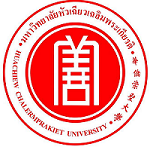Please use this identifier to cite or link to this item:
https://has.hcu.ac.th/jspui/handle/123456789/491Full metadata record
| DC Field | Value | Language |
|---|---|---|
| dc.contributor.advisor | ธิดา โมสิกรัตน์ | - |
| dc.contributor.advisor | Thida Mosikarat | - |
| dc.contributor.author | Sheng, Li | - |
| dc.contributor.other | Huachiew Chalermprakiet University. Faculty of Liberal Arts | - |
| dc.date.accessioned | 2022-07-11T13:25:21Z | - |
| dc.date.available | 2022-07-11T13:25:21Z | - |
| dc.date.issued | 2015 | - |
| dc.identifier.uri | https://has.hcu.ac.th/jspui/handle/123456789/491 | - |
| dc.description | วิทยานิพนธ์ (ศศ.ม.) (การสื่อสารภาษาไทยเป็นภาษาที่สอง) -- มหาวิทยาลัยหัวเฉียวเฉลิมพระเกียรติ, 2558 | th |
| dc.description.abstract | งานวิจัยนี้มีวัตถุประสงค์เพื่อวิเคราะห์ภาพสะท้อนสังคมและวัฒนธรรมในนิทานจีนที่แปลเป็นภาษาไทยและคุณค่าของนิทานจีนที่แปลเป็นภาษาไทย โดยผู้วิจัยวิเคราะห์นิทานจีนที่แปลเป็นภาษาไทยจำนวน 103 เรื่อง และนำเสนอผลการวิจัยแบบพรรณนาวิเคราะห์ ผลการวิจัยพบว่า นิทานจีนที่แปลเป็นภาษาไทยได้สะท้อนภาพสังคมและวัฒนธรรมจีนในด้านวิถีชีวิตและความเป็นอยู่ของชาวจีนที่มีฐานะแตกต่างกัน 3 ชนชั้นได้แก่ ชนชั้นสูง คือ พระราชา ชนชั้นกลาง คือ คนร่ำรวย ข้าราชการ และชนชั้นยากจนที่ใช้แรงงานทำงาน ครอบครัวชาวจีนมีลักษณะเป็นครอบครัวใหญ่มีค่านิยมที่ดี คือ ความขยัน การเคารพเชื่อฟังผู้ใหญ่ การมีสติปัญญาไหวพริบ มีประเพณี และความเชื่อเกี่ยวกับการทำบุญและการทำความดีตามหลักพุทธศาสนา นิทานจีนที่แปลเป็นภาษาไทยมีเนื้อเรื่องเหตุการณ์และตัวละครที่ให้ความสนุกสนานที่เสมือนเป็นเรื่องจริงมีคุณค่าในด้านการให้ความรู้เกี่ยวกับลักษณะของคนจีน การปกครอง และวัฒนธรรม มีคุณค่าด้านการสอนคุณธรรมในด้านความเชื่อฟังผู้ใหญ่และการทำความดี โดยการเล่าเรื่องที่จบด้วยผลของการกระทำผ่านเรื่องราวและบทบาทของตัวละครในนิทานจีนที่แปลเป็นภาษาไทย | th |
| dc.description.abstract | This research aims to analyze the social and culyural reflection of Chinese fairy tales translated into Thai and analyze its appreciation as well. This study analyzes 103 stories of Thai version and presents the findings following the descriptive analysis. The results show that the Chinese tales have reflected the society, culture, and the well-being of the Chinese people which can be classified into 3 different classes; the elites are the king and his family, the middle class are the wealthy or government officers, and the lower class are laborers. The Chinese mostly have large families. Some good values reflecting from the stories are perseverance, adult obedience, incisive wisdom, and beliefs in their traditions, philanthropy, and doing good deeds, following the teaching of Buddhism. The translated version of Chinese tales' characters and events entertain and make fun as if it's real, it also has the appreciation in terms of knowledge of the Chinese authoritarian regimes and culture, including the moral appreciation in obeying adults and doing good deeds.The narration ends with the consequences of the actions, through the stories and the roles of characters. | th |
| dc.language.iso | th | th |
| dc.publisher | มหาวิทยาลัยหัวเฉียวเฉลิมพระเกียรติ | th |
| dc.subject | วัฒนธรรมจีน | th |
| dc.subject | Culture -- China | th |
| dc.subject | จีน -- ความเป็นอยู่และประเพณี | th |
| dc.subject | China -- Social life and customs | th |
| dc.subject | การวิเคราะห์เนื้อหา | th |
| dc.subject | Content analysis (Communication) | th |
| dc.subject | นิทาน -- จีน | th |
| dc.subject | Tales -- China | th |
| dc.title | ภาพสะท้อนสังคมและวัฒนธรรมในนิทานจีนที่แปลเป็นภาษาไทย | th |
| dc.title.alternative | Reflection of Society and Culture in Thai Translations of Chinese Tales | th |
| dc.type | Thesis | th |
| dc.degree.name | ศิลปศาสตรมหาบัณฑิต | th |
| dc.degree.level | ปริญญาโท | th |
| dc.degree.discipline | การสื่อสารภาษาไทยเป็นภาษาที่สอง | th |
| Appears in Collections: | Liberal Arts - Theses | |
Files in This Item:
| File | Description | Size | Format | |
|---|---|---|---|---|
| SHENG-LI.pdf Restricted Access | 2.05 MB | Adobe PDF | View/Open Request a copy |
Items in DSpace are protected by copyright, with all rights reserved, unless otherwise indicated.
